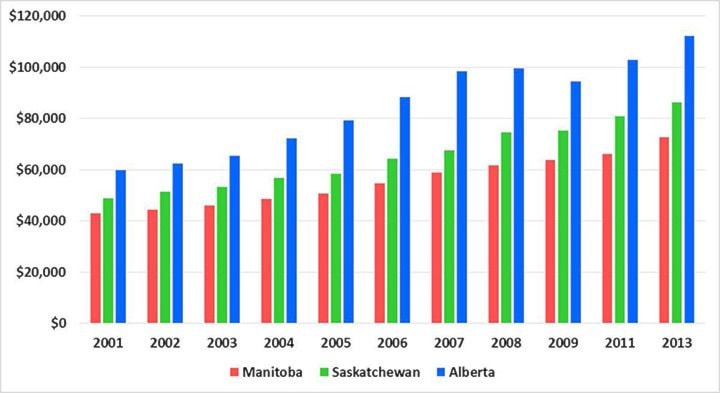Income generated by off-farm employment is becoming a greater part of how family farms in Alberta remain in operation.
This comes from a recently released study from Alberta Agriculture and Forestry (AF) that researched family farm income sources, what’s driving the trend and also compared the province to its prairie neighbours in Saskatchewan and Manitoba.
“Off-farm income in Alberta has strengthened, even more so since the study was finished in 2013,” explained Ryan Furtas, a market analyst/co-ordinating researcher with AF and an author of the study along with AF senior agricultural economist, Zoia Komirenko.
“Simply by the nature of the energy economy, Alberta farms have really seen the benefit of those higher paying jobs,” Furtas added.
The study, which looked at data available from 2001 to 2013, concluded that off-farm income makes up the majority of the average prairie family farm’s total income. In Alberta, off-farm income constituted 79 per cent of the overall household income compared to 74 per cent next door in Saskatchewan and 70 per cent in Manitoba.
Furtas stated off-farm income, mainly jobs outside of agriculture, saw a steady rate of growth over the study period while actual farm incomes remained quite volatile year over year. That volatility can include grain quality, commodity and feed prices, farm expenses and equipment just to name a few.
Over the length of the study, Alberta’s off-farm income grew 88 per cent. Meanwhile, that figure was 76 per cent in Saskatchewan and 69 per cent in Manitoba.
“Both Saskatchewan and Manitoba saw more gradual increases, whereas Alberta had spikes and plateaus mainly due to employment in the energy sector,” he said.
“With the oil boom around 2006, followed by the economic hit in 2009 and then another climb from 2011 to 2013, there were a lot of jobs available and many were high paying ones. Since then, nothing new has happened except the jobs in the current economic climate just are not as high paying.
What really changed over the period that the study looked at, according Furtas, was what now constitutes a family farm.
“It used to be that family farms were easy to define, but now the actual farm structure can be much more complicated,” he said.
“Family farms can now include several siblings or other relatives, the land can be separated between family members or farms have gotten so large that it has been turned into a corporate entity or numbered company — even though it remains owned and operated by the same family.”
The reasons behind the growth in off-farm income, as the study suggests, run the gamut from the type of farm operation and market conditions to its location and family dynamics. However, that growth didn’t have too much to do with how good or bad the farm was doing.
“Farming was doing good (during the study) and farm income had begun to pick up in 2008, although off-farm wages were better,” he stated.
“That reliance (on off-farm income) is now starting to come down as production has improved and farm cash receipts in general have been increasing the last few years. From what we saw, most of the off-farm income is about supplementing or improving the family’s standard of living and less on keeping the farm viable especially with more farm specialization.”
Most farms now focus on one aspect — be it dairy, intensive livestock, growing grain or specializing in some other form of farming instead of operating a more diversified mixed farm.
Furtas added, “Off-farm jobs are a better way to diversify, since one can take advantage of the need for timely labour and better farm technology meaning people are no longer tied to the farm 365 days a year. Plus, farmers now are better equipped with the skills needed to compete in the job market.”
Increasing land values combined with more access to off-farm jobs for the entire family, he said, also play a factor in how much off-farm income can be generated.
